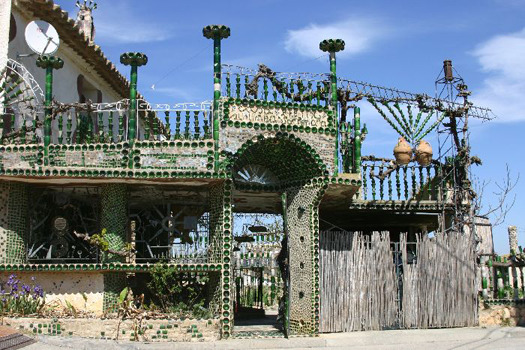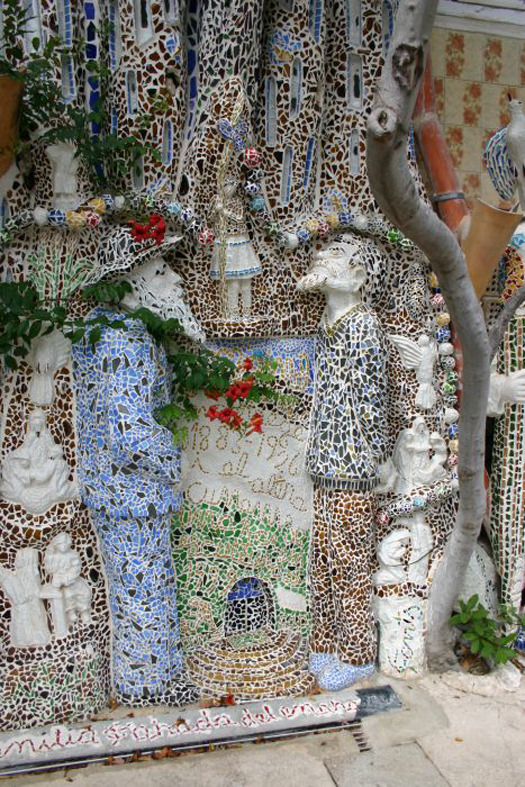The artists represented in the exhibition include Josep Pujiula, renowned internationally for his woven wooden towers and labyrinths, and Francisco González Gragera, whose Capricho de Cotrina is an outstanding example of architectural art brut. The exhibition was exhibited in October at San Jose State University (California, USA) and will travel to other venues in 2014.
Singular Spaces includes more than 5,000 photographs and 1,100 pages in combined print and CD formats that examine intriguing gardens, buildings and artistic constructions, most of which have never been previously published.
Jo Farb Hernández is an internationally-recognized scholar in the field of self-taught artists and visionary environments. She is a Professor and Director of Exhibitions and Special Projects for the School of Art and Art History at San José State University and Director of the SPACES archives. She has worked in the museum field for almost 40 years, including service as President of the California Association of Museums and Director of the Monterey Museum of Art. She is married to sculptor Sam Hernández.
The book is published by Raw Vision of London, England.

Josep Pujiula i Vila: Renowned as creator of one of the most elaborate art environments known worldwide, Pujiula (b. 1937) has been forced three times to demolish his constructions, yet he has always started up again, with each iteration more thoughtful and graceful than the last. At its height (in 2002 and again in 2012), the site included 8-10 towers, some almost 100 feet in height, and a labyrinth over a mile in length, in addition to a series of elaborate concrete, stone, and steel sculptures. The site is once again in danger, but an international movement is mobilizing to protect it.

Josep Pujiula i Vila: View of water feature.

Josep Pujiula i Vila: Twisted labyrinth.

Félix Sanpériz Gistau (ca. 1933-ca. 2008) lived in one of Spain's small villages of less than one hundred inhabitants, a tranquil area where change happened only modestly and incrementally. Yet around 1989 he began ornamenting the house in which he was born, collecting empty green glass cava (Spanish champagne) bottles, ultimately creating a green sheathing cut with organic shapes that changed the environment both inside and out.

Joan Sala Fàbrega (b. 1942) began sculpting a full-size likeness of himself around 1994, although he had no training in art and had never before evidenced any interest in it. Now retired, he has been called the “Gaudí of the Garrotxa” [the province in which he lives], particularly because of his striking abilities with ceramic-tile covered figures. Some are freestanding and others are affixed to the exterior façades of his home; in addition, he also sculpts the local basalt and granite, concentrating on the theme of maternity as well as reproductions of famous sculptures, friends, and family.

A German expatriate, Peter Buch (b. 1938) was lured to Spain in the 1960s by the promises of the sunny beaches. After the islands became too expensive, he found a site high up in the mountains of Castellón where he began to make a garden. Learning by trial-and-error how to build with concrete and stone, this remarkable site includes numerous figural-shaped buildings as well as hundreds of smaller figures, animals, and imaginary creatures, many covered in creatively-placed broken ceramic tiles. It is among the best of Spain's monumental art environment sites.

Peter Buch (b. 1938): Another view of the Peter Buch environment.

Manuel Fulleda Alcaraz: The Casa de las Conchas [House of Shells] sits on the top of a high street on the outskirts of town. After his retirement from a variety of low-paying jobs in 1992, Manuel Fulleda Alcaraz (b. 1933) began ornamenting one of the walls of his home; ultimately, he covered not only every exterior façade, but an intense interior room and a series of six rooftop terraces, each on a slightly different level, and each an irregular polygon in shape. The playfulness of the forms and the intensity of the decoration combine to make this multi-leveled home a spectacular interplay of vibrational form and light.

After retiring from a lifetime of work as a shepherd, Francisco Subirà i Bertran (b. 1924) searched for something to fill his empty hours. Soon he was forming figures out of steel wire and covering them with concrete and found objects; ultimately, dancers, animals, mermaids, and fantastic creatures of myth and legend adorned the yards in front of his home and barn.

Diego Lopez Martínez: Rebelling against the fervent Marianist Catholicism of his mother and community members, Diego López Martínez (b. 1964) dabbled rather seriously in hard drugs, turning tricks and committing petty thefts to fuel his habit. One day, however, he had a revelation that he was, in fact, the reincarnation of Jesus Christ, and was directed by God to paint the mountaintop of his neighborhood blue. This he did, topping the higher rocks with “snowy peaks,” perhaps in an effort to bring heaven to earth as the identical colors of both combine in the mind's eye.

Francisco González Gragera (b. 1925) had a dream of building a country home for himself and his family that would indulge his interest in creating organic forms, a clear departure from his weekday business of cutting rectilinear stone floors, tiles, and even tombstones. Although he has had many interruptions over the years, mostly due to governmental restrictions, he is once again working on his Capricho de Cotrina, replete with fantastic forms, otherworldly plants, and imaginary animals, as he creates one of the most important art environments in Spain.

Emilio Pérez García: Isolated from his community by a worsening deafness after the death of his parents and sister, Emilio Pérez García (1927-2011) began decorating the exterior and interior of his small home with collages and assemblages cut from the brightly-colored publicity announcements that arrived unbidden in his mailbox. He also began painting numbers and numerical-like symbols on the exterior façade, moving on to paint numbers on the streets around his home as well as on the sidewalks, municipal benches, and electrical poles. Given his difficulty communicating, the reason for the numbers or their meanings may never truly be known.

Francisco del Río Cuenca: This modest property, located over 120 miles from the sea, was adorned with some 116 million seashells over the course of a fifty-year period of creativity by Francisco del Río Cuenca (1926-2010). Behind the small home a series of four patios stretch to the bluffs overlooking the river. "Everyone in the world does things," he said, "and I did this so I would be remembered."

Francisco del Río Cuenca (1926-2010): Courtyard View.

José Domínguez Carbajo: Working on the roads near the Camino de Santiago, the pilgrimage trail followed by tens of thousands of international visitors each year, after his retirement José Domínguez Carbajo (b. 1936) began to create brightly-colored sculptures that he thought the pilgrims would enjoy. Not only are there representations of themselves, with staffs and backpacks, but also numerous religious figures--such as this depiction of Adam and Eve fleeing the Garden of Eden--as well as local and mythical animals, and heroes of myth and legend.

Following the drowning of his sailor partner, José María Garrido García (b. 1925) decided to create a museum to memorialize his friend and the lives of all who work the seas. This once-illiterate sailor, who taught himself to read and write, has ornamented the façade and all interiors of this narrow, boat-shaped building with over 80,000 conch shells, as well as with photographs of boats, signs with maritime proverbs, and treasures washed up by the waves. The rooftop terrace features a construction resembling a ship's deck, replete with the captain's bridge and "cannons" on the gunwales to protect the museum from attack.

José María Garrido García (b. 1925)

View of Roof Terrace by José María Garrido García (b. 1925).

The unresolved murders of Julio Basanta López's (b. 1933) son and brother at the hands of the police were instrumental in inspiring him to begin ornamenting the exterior of his weekend home with what he describes as demons. One of the most compelling--and challenging--sites on the entire Spanish mainland, the eighty-year-old Basanta continues to work, painting and repainting his oversized figures, and adding new ones at a feverish pace.

Julio Basanta López (b. 1933)

A poor farmer who finally learned to read during his military service, Máximo Rojo (1912-2005) was so inspired by reading about the wider world that he wanted to share his new knowledge with his neighbors. After his retirement, he began creating hundreds of concrete sculptures for his Museum of History and Life, located on a small piece of farmland at the edge of town. The statues, many now in disrepair, honor allegorical figures including Love, Respect, and Charity; heroes from myth and legend; and real historical figures, such as this group of European leaders who formed the Common Market, the first European Economic Community.
